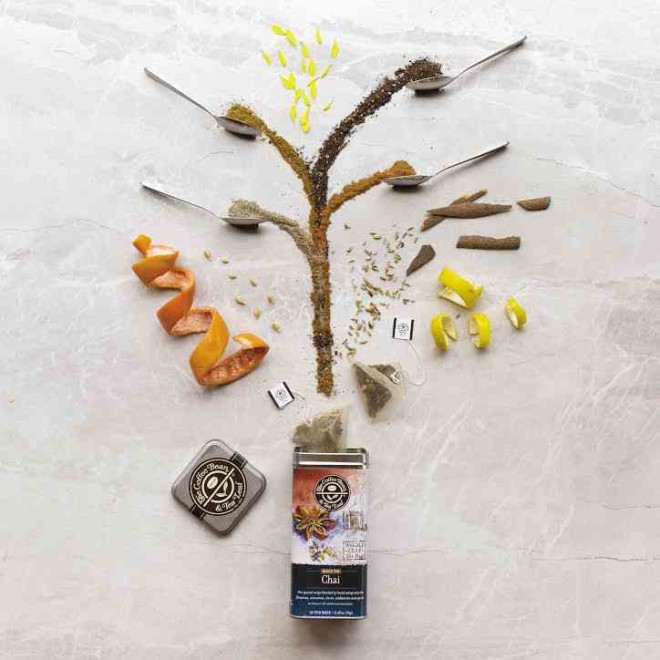
Next to wine, I think coffee is the preferred beverage for pleasure. Coffee has always been the drink to consume, dissect and craft.
But after speaking to David de Candia, master blender for The Coffee Bean & Tea Leaf, I learned that drinking tea is an equally sophisticated ritual with an exacting science.
De Candia is an international tea ambassador with several titles under his name. He travels the world in search of the highest quality teas, and has immersed himself in the tea cultures of Thailand, Taiwan, China, India, Sri Lanka, South Africa, Japan, Kenya, South Korea and Vietnam.
De Candia, together with several chefs in the country, is developing a new line of tea blends infused with local flavors in the Philippines. The special blends will be offered exclusively by The Coffee Bean & Tea Leaf.
Well-being
Here’s what I learned from our brief but enlightening talk.
What exactly is a tea master?
I think a tea master has a different meaning for each person you might ask. When I see “tea master,” I think of a person who has allowed tea to become a bigger part of life. It’s not just a job to create tea for The Coffee Bean & Tea Leaf. It’s connecting the product, the tea leaves, to my well-being.
It reminds me of a perfumery.
It’s funny you say that, because I know a few of them, and whenever I’m traveling and I buy perfume for my wife, they have the same thought process. If I say, “I’m looking for something fruity,” they’ll present a scent to me. If I ask for something with different notes, they’ll give me another perfume. So there are some commonalities among people who have been doing it for years.
Have you tried salabat, which is Filipino ginger tea? Ginger is brewed in a pot for hours.
I haven’t really tried it here yet. I have been here before, so maybe I have. However, ginger tea is not tea. It’s an herb, so a lot of the countries I go to have their own herb blends that are unique to their country of origin.
So what makes a tea? Is it the leaves?
The product has to come from what’s called the Camellia sinensis bush. That’s the actual scientific name of the tea bush. So, if the product doesn’t come from the bush, then it isn’t tea.
Countries have different rituals on how they take their tea. In Manila, did you see any?
I don’t know, but I’ll bet people go to the grocery store and buy boxed Lipton. So they buy tea, go home and use water that’s been sitting on the stove and been reheated over and over again—water that is pretty much tasteless at that point. They have probably been drinking tea for years, but don’t think of the benefits. I’m hearing that Filipinos don’t drink a lot of tea, but they probably do at home. In the morning, maybe, when they’re not feeling well.
I find tea to be more medicinal.
Try a tea latte. It’s not medicinal, it has powder and it has tea. So tea can be very sexy, it doesn’t have to be this grandma kind of beverage. It has iced tea, blended drinks, lattes, so tea is very versatile.
What would you advise me to buy for my house? What are three variants I should have, and how do I offer it to my guests?
We have a Lemon Chamomile that is good for the evening because it doesn’t have caffeine. English Breakfast would be great in the morning with a little milk and sugar. You can also do Longjing, a green tea, at midday for health benefits. You have a multitude of teas that you can drink throughout the day at different times.
Oxidation
All tea comes from the Camellia sinensis bush. While the type of tea—green, black, white or oolong—is determined by the length of time the leaves undergo oxidation, much of the tea’s flavor depends on the quality of the plant. This involves factors such as climate conditions, the health of the soil, even the time of the day it is harvested. All of these elements and more contribute to the enjoyment in every cup of tea.
In the case of The Coffee Bean & Tea Leaf, they ensure that each harvest is limited to the most flavorful parts of the bush—only the the top two leaves and the bud of every plant are plucked to guarantee supreme quality.
Whole leaf teas
Whole leaf teas provide a more balanced cup of flavor, color and aroma, and come in a variety of flavors—from the rich black teas to the more refreshing green teas.
The Coffee Bean & Tea Leaf’s Chai tea is a blend of black tea, cinnamon, clove, cardamom, and other spices that give it a spicy aroma and taste.
The Genmaicha green tea is a mix of Sencha tea, toasted rice and puffed rice, with the Sencha leaves providing subtle flavor and the toasted rice adding some sweetness.
Aside from the classic black and green teas, they also offer flavored black teas, flavored green teas and herbal infusions.
Tropical Passion is a combination of Ceylon black tea, passion fruit, guava fruit flavoring and marigold flowers, and can be served either steeped or as a tea latte.
Strawberry Cream is a combination of Chinese pan-fired green tea, strawberries and vanilla, resulting in a well-balanced and creamy drink.
For those wanting to cut down on caffeine, the coffee shop’s herbal infusions are the best alternative. One of them is the Ginseng Peppermint, a fusion of ginseng, eleuthero root, peppermint and other herbs that increase stamina, reduce stress and boost the immune system.
With these different blends, The Coffee Bean & Tea Leaf is able to offer premium whole leaf teas harvested from the world’s most exclusive tea estates, and steeped in a variety of tea cultures.
Visit coffeebean.com.ph or facebook.com/coffeebeanphilippines.
Follow @cbtlph on Twitter and Instagram.